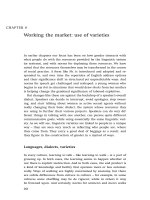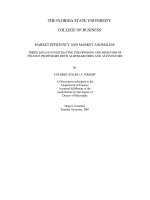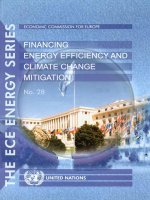Fi8000 Market Efficiency
Bạn đang xem bản rút gọn của tài liệu. Xem và tải ngay bản đầy đủ của tài liệu tại đây (1.11 MB, 33 trang )
Fi8000
Valuation of
Financial Assets
Spring Semester 2010
Dr. Isabel Tkatch
Assistant Professor of Finance
CAPM Review
Under strict assumptions, the CAPM results in a
prescription for a fair return (price):
The fair expected return on an asset depends only
on the market risk premium and on the measure
of systematic risk beta.
Stocks with high betas have higher expected
return, stock with low betas have lower expected
return, but there is no compensation for any risk
factor other than the systematic market risk (beta).
CAPM Critique
☺Roll (1977) points out that the CAPM is not
directly testable
It is a one period model
☺The market portfolio cannot be identified empirically
☺To test the model, we need the market portfolio to be
on the “efficient frontier” (proxies won’t work)
☺
☺Indirect tests fail to support the CAPM
☺
Other risk factors are priced (firm size, book-to-market
ratio), but there is no theoretical (economic)
explanation for these risk factors.
Market Efficiency - Overview
☺Efficient market:
Returns are fair / normal = The market is in equilibrium
☺Key Insight:
We can test whether returns are fair / normal
only within the context of (assuming)
a specific asset pricing model
We can test the asset pricing model
only within the context of (assuming)
a market that is in equilibrium / efficient
Normal and Abnormal Returns
☺Normal returns:
Fair or equilibrium returns given by a theoretical
asset pricing model like the CAPM
☺Abnormal returns:
Returns that are systematically higher (or
lower) than the normal returns
Normal and Abnormal Returns
☺ For each asset
i the CAPM predicts a fair / normal, riskadjusted rate of return:
E(Ri) = rf + βi [ E(Rm) – rf ]
☺ We observe asset
i over time t, and compare the
realized return Rit to the model (CAPM) return:
αit = Rit – E(Ri) = Rit – { rf + βi [ E(Rmt) – rf ] }
☺ If the realized return of asset
i is systematically higher
than the model (CAPM) return, we say that the return of
asset i is abnormal.
Abnormal return: Average[ αit ] = [αi1 + αi2 +…+ αiT] / T > 0
The Efficient Market Hypothesis
☺Three forms of efficiency:
Weak form market efficiency
☺Semi-Strong form market efficiency
☺Strong form market efficiency
☺
☺Note that the EMH is a Hypothesis
We should look for evidence that reject the hypothesis
☺We should look for evidence to decide which form of
EMH is more likely
☺
Weak Form Efficiency
☺Definition:
A market is weak form efficient if the current
asset prices reflect all historical price
information
☺Implication:
Trading strategies based on the analysis of
historical prices should not yield abnormal
returns (on average!)
Semi-Strong Form Efficiency
☺Definition:
A market is semi-strong form efficient if the
current asset price reflects all publicly available
information
☺Implication:
Trading strategies based on the analysis of
publicly available information (fundamental
analysis such as analyst reports) should not
yield abnormal returns (on average!)
Strong Form Efficiency
☺Definition:
A market is strong form efficient if the current
asset price reflects all information (including
private / insider information)
☺Implication:
There is no (legal) trading strategy that yields
abnormal returns (on average!). One cannot
make money even by following the trades of
informed insiders.
Nesting
☺Information:
Information about past prices
is included in the set of publicly available information,
which is included in the complete set of information.
☺Market efficiency:
The strong form of market efficiency implies
the semi-strong, which implies
the weak form.
Note that the strongest form of the EMH is the strongest
and the most restricting efficiency assumption: the
complete set of information is included in the prices.
Evidence of Weak Form EMH
☺Consistent evidence:
Technical trading rules, based on past price
patterns, do not appear to be profitable.
☺Contradicting evidence:
The “January” effect – almost every January,
stock returns (usually for small firms) are
positive.
Evidence of
Semi-Strong Form EMH
☺Consistent evidence:
New publicly available information (such as earnings
release) affects prices quickly.
☺Contradicting evidence:
Small firms and firms with high ratio of book-value to
market-value have, on average, higher returns.
Some portfolio managers consistently outperform the
market (Peter Lynch, Warren Buffet, John Templeton
and John Neff are in Paul Samuelson’s hall of fame,
1989).
Evidence of Strong Form
EMH
☺Consistent evidence:
Insiders of corporations appear able to earn abnormal
returns from their trades. On average, price increases
just after insiders purchase the stock and decreases
just after a they sell the stock.
☺Contradicting evidence:
Prices react to public information that had been private.
For example, prices react to earning announcements
even though someone must have known their content
before the official announcement day.
Market Efficiency and Equilibrium
☺An efficient market is a market in (CAPM)
equilibrium
☺Inefficient markets occur when asset
prices are different from their equilibrium
prices
☺In theory, traders who exploit market
inefficiencies should move market prices
back to their fair / equilibrium level.
The Joint Hypothesis Problem
☺A test of market efficiency can only be conducted
by using a theoretical asset pricing model to
define normal returns (fair prices)
☺Finding an abnormal average return can be
interpreted in more than one way:
Reject the Market Efficiency Hypothesis (MEH)
☺Reject the theoretical asset pricing model of fair /
normal returns
☺Reject both
☺
MEH – Are Markets Efficient?
☺ Grossman and Stigliz (1980): the logical question must
always be to what extent markets are efficient
☺ Empirical evidence
☺ Implications for trading strategies?
☺Technical analysis
☺Fundamental analysis
☺Trading on insider information
☺ Is there a portfolio manager who systematically
outperforms the market?
Is a small abnormal return detectable?
☺Will they tell us about their winning strategy (selection bias)?
☺How can we distinguish between luck and talent?
☺
Economist on Market Efficiency
Eugene Fama, of the University of Chicago,
defined its essence: that the price of a
financial asset reflects all available
information that is relevant to its value.
Efficiency and beyond
The Economist, Jul 16th 2009
Economist on Market Efficiency Cont.
From that idea powerful conclusions were drawn, not least on
Wall Street. If the EMH held, then markets would price financial
assets broadly correctly. Deviations from equilibrium values
could not last for long. If the price of a share, say, was too low,
well-informed investors would buy it and make a killing. If it
looked too dear, they could sell or short it and make money that
way. It also followed that bubbles could not form—or, at any rate,
could not last: some wise investor would spot them and pop
them. And trying to beat the market was a fool’s errand for
almost everyone. If the information was out there, it was already
in the price.
Economist on Market Efficiency Cont.
Mr Scholes thinks much of the blame for the recent woe should be
pinned not on economists’ theories and models but on those on Wall
Street and in the City who pushed them too far in practice.
He has also been “criticizing for years” the “value-at-risk” (VAR)
models used by institutional investors to work out how much capital
they need to set aside as insurance against losses on risky assets.
These models mistakenly assume that the volatility of asset prices
and the correlations between prices are constant , says Mr Scholes.
When, say, two types of asset were assumed to be uncorrelated,
investors felt able to hold the same capital as a cushion against
losses on both, because they would not lose on both at the same
time. However, as Mr Scholes discovered at LTCM and as the entire
finance industry has now learnt for itself, at times of market stress
assets that normally are uncorrelated can suddenly become highly
correlated. At that point the capital buffer implied by VAR turns out to
be woefully inadequate.
Economist on Market Efficiency Cont.
In 1980 Sanford Grossman and Joseph Stiglitz, another
subsequent winner of a Nobel prize, pointed out a paradox.
If prices reflect all information, then there is no gain from
going to the trouble of gathering it, so no one will. A little
inefficiency is necessary to give informed investors an
incentive to drive prices towards efficiency.
Economist on Market Efficiency Cont.
However, a second branch of financial economics is far more
skeptical about markets’ inherent rationality. Behavioral
economics, which applies the insights of psychology to finance,
has boomed in the past decade.
Mr Thaler concedes that in some ways the events of the past
couple of years have strengthened the EMH. The hypothesis has
two parts, he says: the “no-free-lunch part and the price-is-right
part, and if anything the first part has been strengthened as we
have learned that some investment strategies are riskier than
they look and it really is difficult to beat the market.” The idea
that the market price is the right price, however, has been badly
dented.
Economist on Market Efficiency Cont.
Financial economists also need better theories of why
liquid markets suddenly become illiquid and of how to
manage the risk of “moral hazard”—the danger that the
existence of government regulation and safety nets
encourages market participants to take bigger risks than
they might otherwise have done. The sorry consequences
of letting Lehman Brothers fail, which was intended to
discourage moral hazard, showed that the middle of a crisis
is not the time to get tough. But when is?
Lucas on the EMH and the Crisis
THERE is widespread disappointment with
economists now because we did not
forecast or prevent the financial crisis of
2008. … two fields, macroeconomics and
financial economics …
Robert Lucas, University of Chicago
In defense of the dismal science
The Economist, Aug 6th 2009
Lucas on the EMH Cont.
One thing we are not going to have, now or ever, is a set of
models that forecasts sudden falls in the value of financial
assets, like the declines that followed the failure of Lehman
Brothers in September. This is nothing new. It has been known
for more than 40 years and is one of the main implications of
Eugene Fama’s “efficient-market hypothesis” (EMH), which
states that the price of a financial asset reflects all relevant,
generally available information. If an economist had a formula
that could reliably forecast crises a week in advance, say, then
that formula would become part of generally available
information and prices would fall a week earlier. (The term
“efficient” as used here means that individuals use information in
their own private interest. It has nothing to do with socially
desirable pricing; people often confuse the two.)









